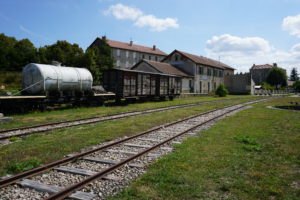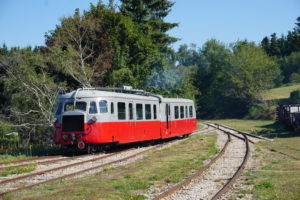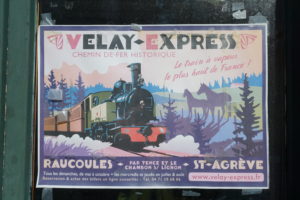August 24: I recently stayed in a small hotel in St. Agreve. It was adjacent to the train station, which appeared to be closed. However, on closer inspection, I found that it was one of five stations on the Velay Express Railway which turned out to have a long and interesting history.
 In 1878, the government of France decided to construct more than 11,000 KM of rail lines linking the major centres and attractions across the country. Some portions of the railway system, including the Velay were built with a narrower gauge and steeper inclines which permitted sharper corners and climbs better able to adapt to rugged terrain.
In 1878, the government of France decided to construct more than 11,000 KM of rail lines linking the major centres and attractions across the country. Some portions of the railway system, including the Velay were built with a narrower gauge and steeper inclines which permitted sharper corners and climbs better able to adapt to rugged terrain.
When the ultimate cost of the entire system was found to be prohibitive, it was decided that individual departments within the country could manage their own portion of the network. So, like many parts of the system, the Velay lines do not connect outside the department. Ultimately about 200 KM of narrow gauge rail was built and service continued until 1968 when it became uneconomic. An association was then formed by local residents and businesses with the objective of operating the remaining rail lines as a tourist attraction.
 Today they operate two engines including a steam engine dating from 1890, and an autocar dating from 1949. The morning after I arrived, the autocar emerged from its’ shed, clattering and banging amidst a cloud of blue diesel smoke. It sat idling, occasionally farting a backfire that threatened to stall the motor, while various guys wandered around apparently getting ready for the morning run. In due course, amidst great fanfare and blowing or whistles, passengers were invited aboard and it ambled off down the track toward Le Chambon.
Today they operate two engines including a steam engine dating from 1890, and an autocar dating from 1949. The morning after I arrived, the autocar emerged from its’ shed, clattering and banging amidst a cloud of blue diesel smoke. It sat idling, occasionally farting a backfire that threatened to stall the motor, while various guys wandered around apparently getting ready for the morning run. In due course, amidst great fanfare and blowing or whistles, passengers were invited aboard and it ambled off down the track toward Le Chambon.
The schedule is set up so that you can travel out on the autocar, and return an hour or so later on the steam train which started out at the other end of the line. On this day, disaster struck when the steam train, or one of it’s cars (it really wasn’t very clear) derailed. That occurred at a place where the autocar could not pass, which effectively meant the entire system was shut down and the passengers marooned until the association members could figure out how to get the machinery back on track.
 Although the whole business had a Rube Goldberg air to it, I was impressed by the ingenuity these guys showed in restoring the line and the equipment, and then operating a tourist attraction that drew about 18,000 people in the last 2 years. I have no idea how they were going to fix this particular problem, and I couldn’t really hang about to find out. But I left admiring the determination, the idealism and the commitment these guys showed in continuing to operate their trains.
Although the whole business had a Rube Goldberg air to it, I was impressed by the ingenuity these guys showed in restoring the line and the equipment, and then operating a tourist attraction that drew about 18,000 people in the last 2 years. I have no idea how they were going to fix this particular problem, and I couldn’t really hang about to find out. But I left admiring the determination, the idealism and the commitment these guys showed in continuing to operate their trains.